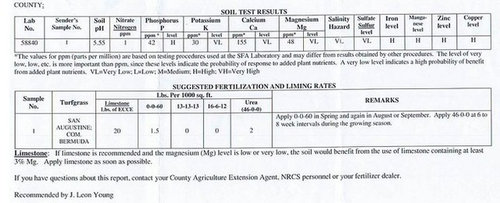2nd property soil test results
nick-et
9 years ago
Related Stories

GARDENING GUIDESHow to Stop Worrying and Start Loving Clay Soil
Clay has many more benefits than you might imagine
Full Story
GARDENING GUIDES10 Solutions for Soggy Soil
If a too-wet garden is raining on your parade, try these water-loving plants and other ideas for handling all of that H2O
Full Story
COLORSpeed-Dial Color Selection to Get the Best Result
You’ve belabored your color decisions and are still stuck. Here is how to evaluate your space and make choices that are right for you
Full Story
GARDENING GUIDESGet the Dirt on Your Garden’s Soil
Understand how your soil supports your plants so you can ensure your garden’s success
Full Story
GARDENING GUIDESHave Acidic Soil in Your Yard? Learn to Love Gardening Anyway
Look to acid-loving plants, like conifers and rhododendrons, to help your low-pH garden thrive
Full Story
GARDENING GUIDESGrow a Beautiful Garden in Alkaline Soil
Got alkaline soil? Learn how to manage it and the many beautiful plants that will thrive in this ‘sweet’ soil
Full Story
FARM YOUR YARDHow to Get Good Soil for Your Edible Garden
The nutrients in your soil feed the plants that feed you. Here are tips on getting it right — just in time for planting season
Full Story
LANDSCAPE DESIGNHow to Shape a Rain Garden and Create the Right Soil for It
Learn how to grade, lay out and amend the soil in your rain garden to support your plants
Full Story
GARDENING GUIDESGardening Solutions for Heavy Clay Soils
What’s a gardener to do with soil that’s easily compacted and has poor drainage? Find out here
Full Story
GARDENING GUIDESThe Poop Scoop: Enrich Your Soil With Good Old Manure
Get over the ick factor already — this natural super-ingredient for soil has so many benefits, you'll wonder why you ever went chemical
Full StorySponsored
Custom Craftsmanship & Construction Solutions in Franklin County
More Discussions







johns.coastal.patio
toxcrusadr
Related Professionals
Danbury Landscape Architects & Landscape Designers · Panama City Landscape Architects & Landscape Designers · Rancho Cordova Landscape Architects & Landscape Designers · Brentwood Landscape Contractors · Wake Forest Landscape Contractors · Arden-Arcade Landscape Contractors · Hannibal Landscape Contractors · Leicester Landscape Contractors · Oak Forest Landscape Contractors · Waipahu Landscape Contractors · Crystal Lake Decks, Patios & Outdoor Enclosures · Fort Myers Decks, Patios & Outdoor Enclosures · Minneapolis Decks, Patios & Outdoor Enclosures · Riverside Decks, Patios & Outdoor Enclosures · Salisbury Decks, Patios & Outdoor EnclosuresKimmsr
toxcrusadr
nick-etOriginal Author
Kimmsr
toxcrusadr
Slimy_Okra
nick-etOriginal Author
toxcrusadr
Kimmsr
toxcrusadr
Mackel-in-DFW
Mackel-in-DFW
nick-etOriginal Author
Mackel-in-DFW
nick-etOriginal Author
nick-etOriginal Author
Mackel-in-DFW